maintenance HONDA ACCORD HYBRID 2014 9.G Owners Manual
[x] Cancel search | Manufacturer: HONDA, Model Year: 2014, Model line: ACCORD HYBRID, Model: HONDA ACCORD HYBRID 2014 9.GPages: 561, PDF Size: 20.3 MB
Page 1 of 561
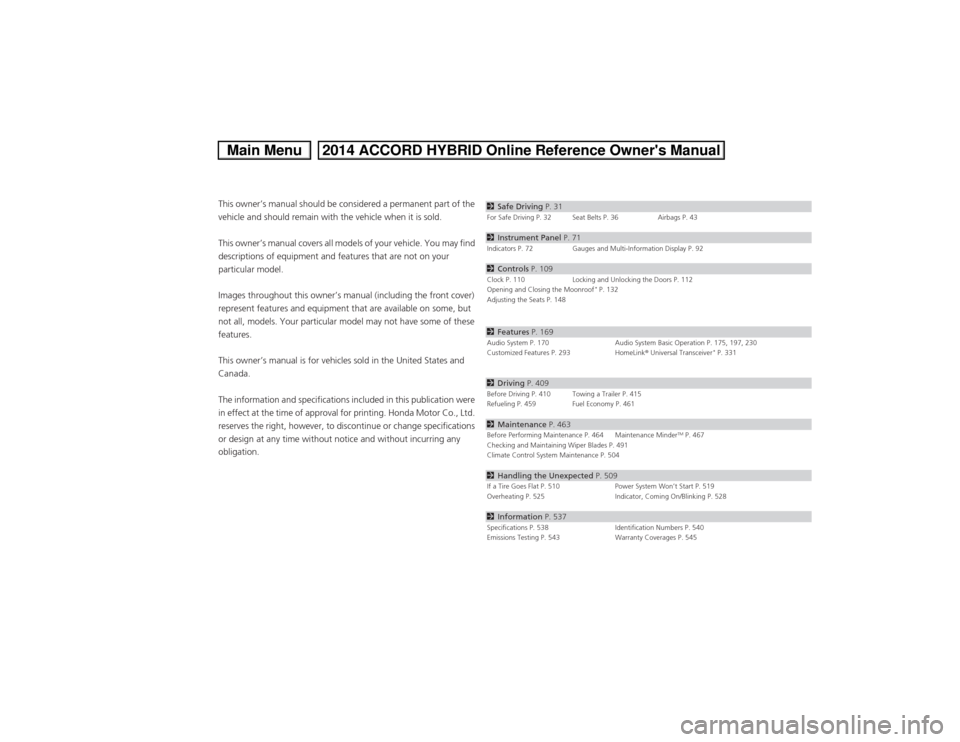
Contents
This owner’s manual should be considered a permanent part of the
vehicle and should remain with the vehicle when it is sold.
This owner’s manual covers all models of your vehicle. You may find
descriptions of equipment and features that are not on your
particular model.
Images throughout this owner’s manual (including the front cover)
represent features and equipment that are available on some, but
not all, models. Your particular model may not have some of these features.
This owner’s manual is for vehicles sold in the United States and Canada.
The information and specifications included in this publication were
in effect at the time of approval for printing. Honda Motor Co., Ltd.
reserves the right, however, to discontinue or change specifications
or design at any time without notice and without incurring any
obligation.2 Safe Driving P. 31For Safe Driving P. 32 Seat Belts P. 36 Airbags P. 43
2Instrument Panel P. 71Indicators P. 72 Gauges and Multi-Information Display P. 92
2Controls P. 109Clock P. 110 Locking and Unlocking the Doors P. 112
Opening and Closing the Moonroof *
P. 132
Adjusting the Seats P. 148
2 Features P. 169Audio System P. 170 Audio System Basic Operation P. 175, 197, 230
Customized Features P. 293 HomeLink ® Universal Transceiver *
P. 331
2 Driving P. 409Before Driving P. 410 Towing a Trailer P. 415
Refueling P. 459 Fuel Economy P. 461
2Maintenance P. 463Before Performing Maintenance P. 464 Maintenance Minder TM
P. 467
Checking and Maintaining Wiper Blades P. 491
Climate Control System Maintenance P. 504
2 Handling the Unexpected P. 509If a Tire Goes Flat P. 510 Power System Won’t Start P. 519
Overheating P. 525 Indicator, Coming On/Blinking P. 528
2Information P. 537Specifications P. 538 Identification Numbers P. 540
Emissions Testing P. 543 Warranty Coverages P. 545
Main Menu2014 ACCORD HYBRID Online Reference Owner's Manual
Page 2 of 561
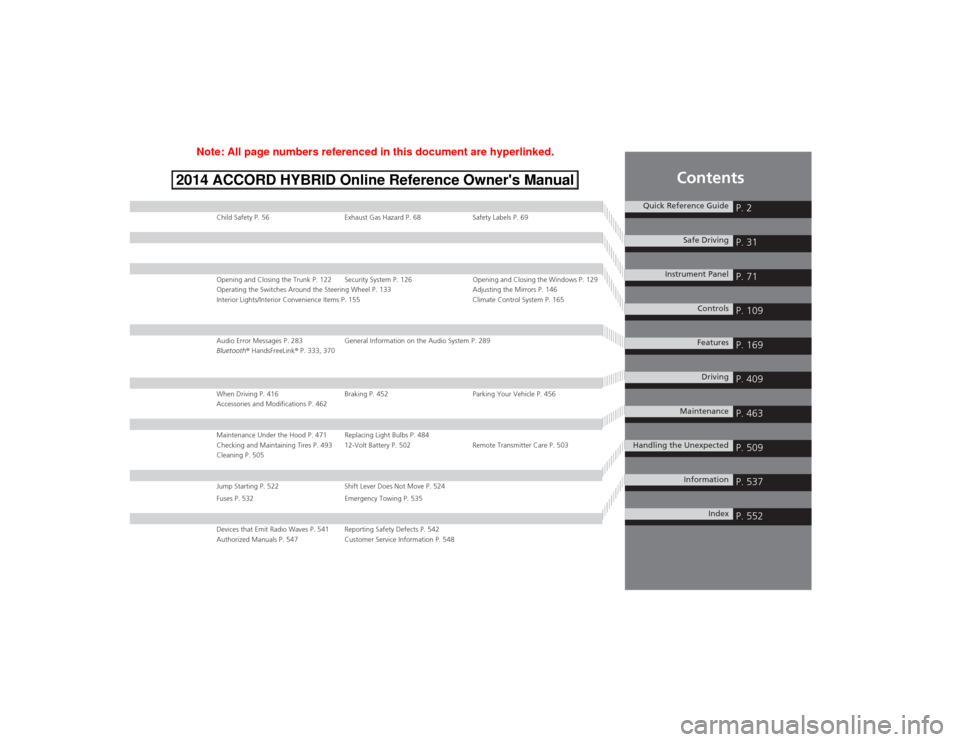
Contents
Child Safety P. 56 Exhaust Gas Hazard P. 68 Safety Labels P. 69
Opening and Closing the Trunk P. 122 Security System P. 126 Opening and Closing the Windows P. 129
Operating the Switches Around the Steering Wheel P. 133 Adjusting the Mirrors P. 146
Interior Lights/Interior Convenience Items P. 155 Climate Control System P. 165
Audio Error Messages P. 283 General Information on the Audio System P. 289
Bluetooth® HandsFreeLink ® P. 333, 370
When Driving P. 416 Braking P. 452 Parking Your Vehicle P. 456
Accessories and Modifications P. 462
Maintenance Under the Hood P. 471 Replacing Light Bulbs P. 484
Checking and Maintaining Tires P. 493 12-Volt Battery P. 502 Remote Transmitter Care P. 503
Cleaning P. 505
Jump Starting P. 522 Shift Lever Does Not Move P. 524
Fuses P. 532 Emergency Towing P. 535
Devices that Emit Radio Waves P. 541 Reporting Safety Defects P. 542
Authorized Manuals P. 547 Customer Service Information P. 548
Quick Reference GuideP. 2
Safe DrivingP. 31
Instrument PanelP. 71
ControlsP. 109
FeaturesP. 169
DrivingP. 409
MaintenanceP. 463
Handling the UnexpectedP. 509
InformationP. 537
IndexP. 552
Note: All page numbers referenced in this document are hyperlinked.
2014 ACCORD HYBRID Online Reference Owner's Manual
Page 7 of 561
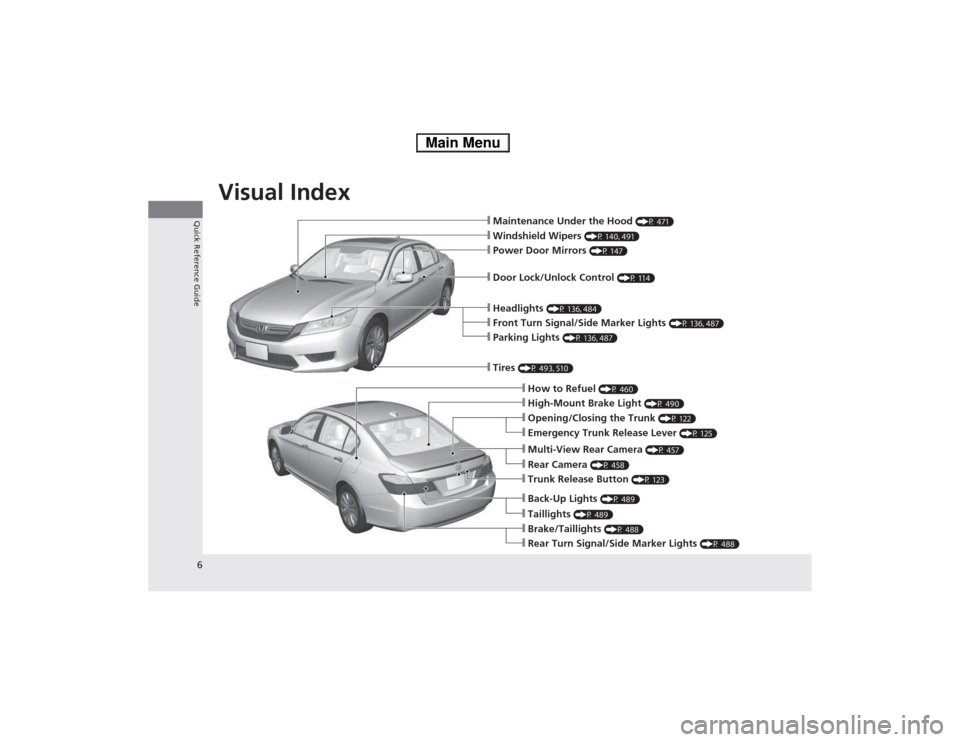
Visual Index
6
Quick Reference Guide❙Maintenance Under the Hood (P 471)
❙Windshield Wipers (P 140, 491)
❙Tires (P 493, 510)
❙Door Lock/Unlock Control (P 114)
❙Power Door Mirrors (P 147)
❙Headlights (P 136, 484)
❙How to Refuel (P 460)
❙High-Mount Brake Light (P 490)
❙Emergency Trunk Release Lever (P 125)
❙Opening/Closing the Trunk (P 122)
❙Parking Lights (P 136, 487)
❙Front Turn Signal/Side Marker Lights (P 136, 487)
❙Multi-View Rear Camera (P 457)
❙Trunk Release Button (P 123)
❙Back-Up Lights (P 489)
❙Taillights (P 489)
❙Brake/Taillights (P 488)
❙Rear Turn Signal/Side Marker Lights (P 488)
❙Rear Camera (P 458)
Main Menu
Page 13 of 561

12
Quick Reference Guide
Safety PrecautionsDo not touch the High Voltage system
Attempting to take a High Voltage system component apart or disconnect one of its wires
can cause severe electrical shock. If the High Voltage system needs maintenance or repair, it
should be performed at a dealer. If a crash occurs ● Be careful of electric shock hazard.
uIf a severe crash damages your vehicle’s High Voltage system, there is a possibility of
electrical shock due to exposed High Voltage components or wires. If this happens, do not
touch any of the High Voltage system components or any of its orange wires. ● Avoid contact with High Voltage battery fluid.
uThe High Voltage battery contains a flammable electrolyte that could leak as a result of
a severe crash. Avoid any skin or eye contact with the electrolyte as it is corrosive. If you
accidentally touch it, flush your eyes or skin with a large quantity of water for at least five
minutes, and seek medical attention immediately. ● Use a fire extinguisher for an electrical fire.
uAttempting to extinguish an electrical fire with a small quantity of water, from a garden
hose for instance, can be dangerous. ● Anytime the vehicle is damaged in an accident, have it repaired by a dealer.
Emergency Shutdown System for the High Voltage System
The emergency shutdown system may activate when the vehicle is impacted by some
incident such as a crash. When this system activate s, the High Voltage system automatically
shuts down, and your vehicle no longer will move under its own power. To return the High
Voltage system back to normal operation, consult a dealer.
Honda collects and recycles High Voltage batt eries used in its vehicles – consult a dealer for
more information.
Do not cover the air intake.
If the air intake is obstructed
during vehicle operation, the High
Voltage battery can become too
hot. To protect the battery, the
system may start to limit the
battery’s output and cause the
power system and 12-volt battery
charging system indicators to come
on. Air Intake
Main Menu
Page 26 of 561
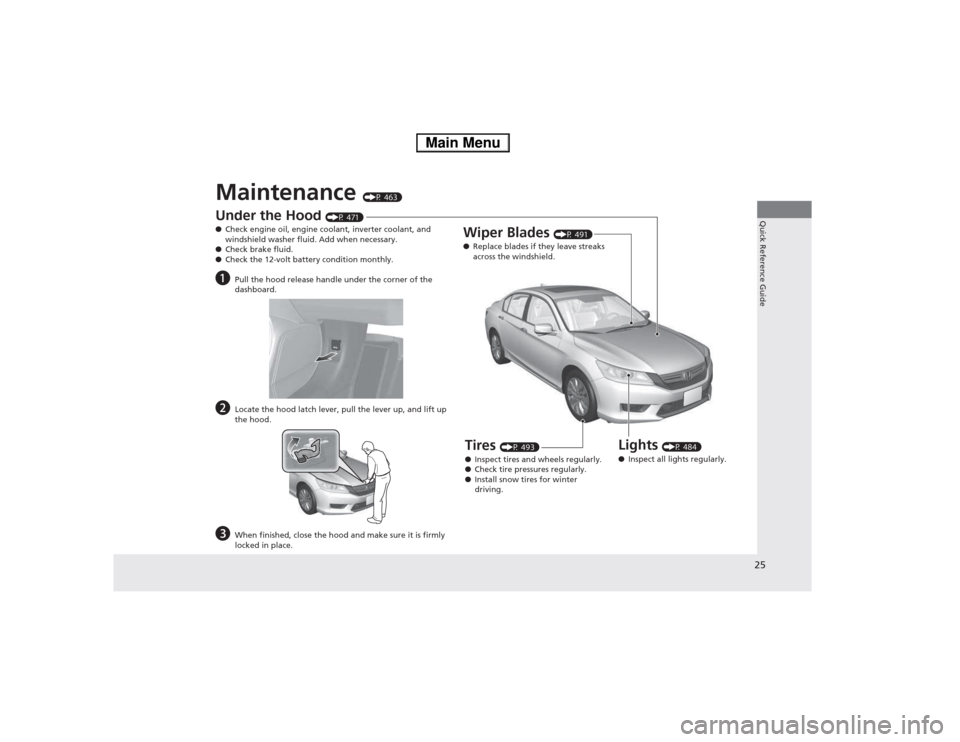
25
Quick Reference Guide
Maintenance (P 463)
Under the Hood (P 471)
● Check engine oil, engine coolant, inverter coolant, and
windshield washer fluid. Add when necessary.
● Check brake fluid.
● Check the 12-volt battery condition monthly.
a Pull the hood release handle under the corner of the
dashboard.
b Locate the hood latch lever, pull the lever up, and lift up
the hood.
c When finished, close the hood and make sure it is firmly
locked in place.
Lights (P 484)
● Inspect all lights regularly.
Wiper Blades
(P 491)
● Replace blades if they leave streaks
across the windshield.
Tires (P 493)
● Inspect tires and wheels regularly.
● Check tire pressures regularly.
● Install snow tires for winter
driving.
Main Menu
Page 34 of 561
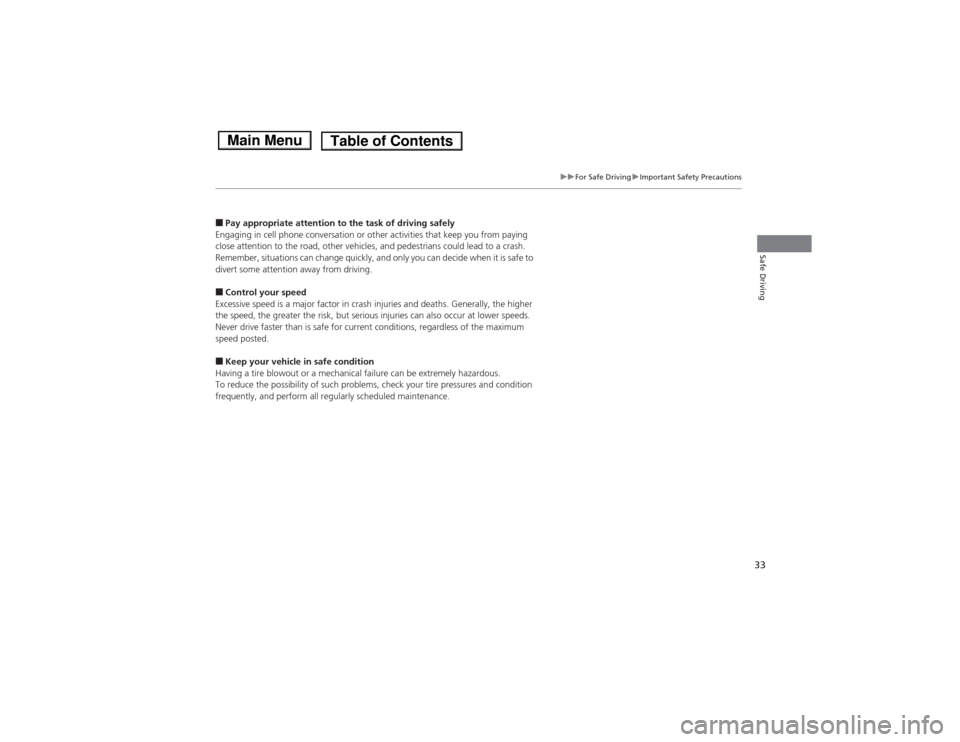
33
uuFor Safe DrivinguImportant Safety Precautions
Safe Driving
■Pay appropriate attention to the task of driving safely
Engaging in cell phone conversation or other activities that keep you from paying
close attention to the road, other vehicles, and pedestrians could lead to a crash.
Remember, situations can change quickly, and only you can decide when it is safe to
divert some attention away from driving. ■ Control your speed
Excessive speed is a major factor in crash injuries and deaths. Generally, the higher
the speed, the greater the risk, but serious injuries can also occur at lower speeds.
Never drive faster than is safe for current conditions, regardless of the maximum speed posted. ■ Keep your vehicle in safe condition
Having a tire blowout or a mechanical failure can be extremely hazardous.
To reduce the possibility of such problems, check your tire pressures and condition
frequently, and perform all regularly scheduled maintenance.
Table of ContentsMain Menu
Page 56 of 561
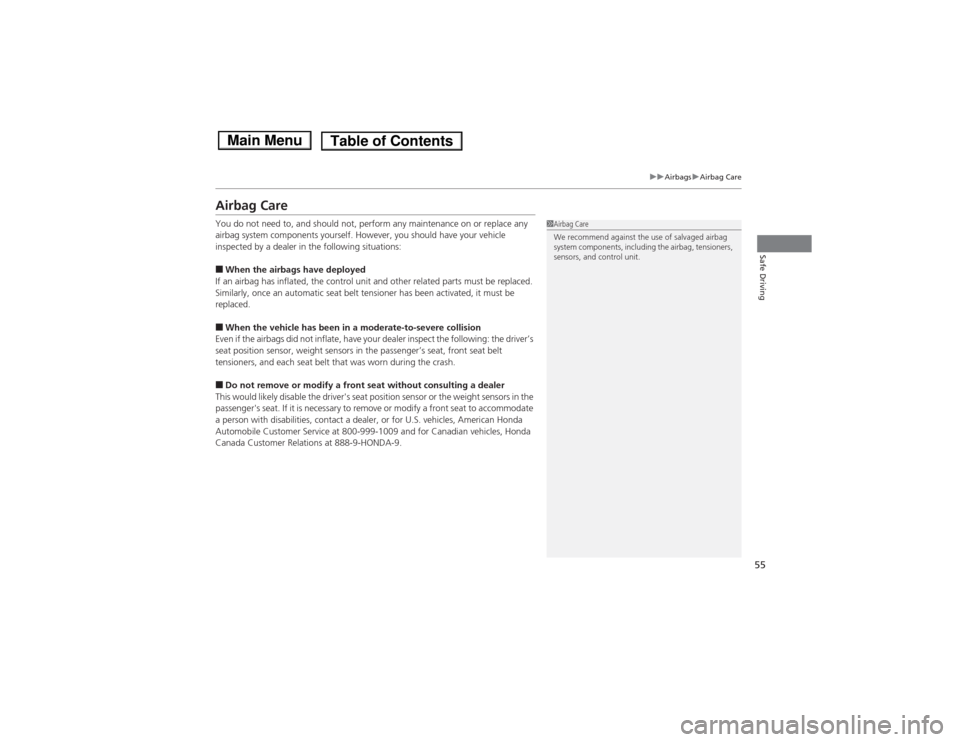
55
uuAirbagsuAirbag Care
Safe Driving
Airbag Care
You do not need to, and should not, perform any maintenance on or replace any
airbag system components yourself. However, you should have your vehicle
inspected by a dealer in the following situations: ■When the airbags have deployed
If an airbag has inflated, the control unit and other related parts must be replaced.
Similarly, once an automatic seat belt tensioner has been activated, it must be
replaced. ■ When the vehicle has been in a moderate-to-severe collision
Even if the airbags did not inflate, have your dealer inspect the following: the driver’s
seat position sensor, weight sensors in the passenger’s seat, front seat belt
tensioners, and each seat belt that was worn during the crash. ■ Do not remove or modify a front seat without consulting a dealer
This would likely disable the driver's seat position sensor or the weight sensors in the
passenger's seat. If it is necessary to remove or modify a front seat to accommodate
a person with disabilities, contact a dealer, or for U.S. vehicles, American Honda
Automobile Customer Service at 800-999-1009 and for Canadian vehicles, Honda
Canada Customer Relations at 888-9-HONDA-9.
1Airbag Care
We recommend against the use of salvaged airbag
system components, including the airbag, tensioners, sensors, and control unit.
Table of ContentsMain Menu
Page 85 of 561

84
uuIndicatorsuMulti-Information Display Warning and Information Messages
Instrument Panel
Multi-Information Display Warning and Information Messages
The following messages appear only on the multi-information display. Press the (information) button to see the message again
with the system message indicator on.
MessageConditionExplanation
● Appears when the fuel fill cap is loose or is not
installed.
2 Tighten Fuel Cap Message P. 529
●
Appears when the scheduled maintenance is due
soon.
uConsequently, Maintenance Due Now and
Maintenance Past Due follow.2Maintenance Minder Messages on the Multi-
Information Display P. 468
●
Appears when the engine coolant temperature gets
abnormally high.
2 Overheating P. 525
●
Appears when the engine coolant temperature is
near its upper limit.●Drive slowly to prevent overheating.
●
Appears if any door or the trunk is not completely closed.
● The beeper sounds and the message comes on if any
door or the trunk is opened while driving.●
Goes off when all doors and the trunk are closed.
Main MenuTable of Contents
Page 98 of 561

Continued97
uuGauges and Multi-Information DisplayuMulti-Information Display
Instrument Panel
Shows the average speed in mph (U.S.) or km/h (Canada) since Trip A or Trip B was
reset.
Shows the instant fuel economy as a bar graph in mpg (U.S.) or l/100 km (Canada).
Shows the remaining oil life and Maintenance MinderTM
.
2 Maintenance Minder TM
P. 467
Shows the outside temperature in Fahrenheit (U.S.) or Celsius (Canada). ■ Adjusting the outside temperature display
Adjust the temperature reading up to ±5°F or ±3°C if the temperature reading seems incorrect.
Shows you turn-by-turn driving directions to your destination linked with the
navigation system *
.
2 Refer to the Navigation System Manual
■Average Speed
■Instant Fuel Economy
■Engine Oil Life
■Outside Temperature
■Turn-by-Turn Directions *
1Average Speed
You can change when to reset the average speed.
2 Customized Features P. 101, 293
1Outside Temperature
The temperature sensor is in the front bumper.
Road heat and exhaust from another vehicle can
affect the temperature reading when your vehicle
speed is less than 19 mph (30 km/h).
It may take several minutes for the display to be
updated after the temperature reading has stabilized.
Use the multi-information display's customized
features to correct the temperature.
2 Customized Features P. 101, 293
1Turn-by-Turn Directions*
You can select whether the turn-by-turn display
comes on during the route guidance. 2 Customized Features P. 101, 293
* Not available on all models
Main MenuTable of Contents
Page 104 of 561

103
uuGauges and Multi-Information DisplayuMulti-Information Display
Continued
Instrument Panel
Exit
4
4
4
Door Setup
Maintenance Reset
Default All
SEL/RESET
4
SEL/RESET
4
Lighting SetupSEL/RESET
4
Key And Remote Unlock Mode
Auto Door Lock
Auto Door Unlock
Keyless Lock Answer Back
Security Relock Timer
Interior Light Dimming Time
Headlight Auto Off Timer
Auto Light Sensitivity
4
4
Main MenuTable of Contents